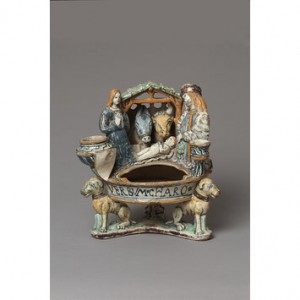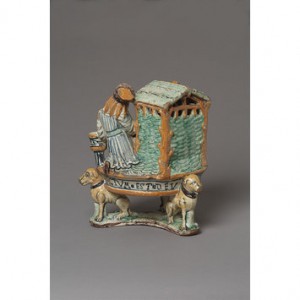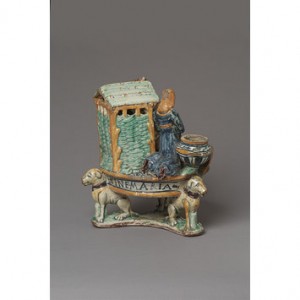Katherine Tycz, a PhD candidate in the Italian Department at the University of Cambridge and a member of the research project funded by the European Research Council, Domestic Devotions: The Place of Piety in the Renaissance Italian Home, 1400-1600 writes here about a sixteenth-century inkstand from Tuscany.
 Nativity Inkstand; maiolica (tin-glazed earthenware); Tuscany, c. 1510
Nativity Inkstand; maiolica (tin-glazed earthenware); Tuscany, c. 1510
Victoria & Albert Museum 396-1889; images courtesy of the V&A.
‘VERBVM*CHARO*FACTUM*EST*DE VIGINE*MARIA*’—the words emblazoned in blue around the base of this ceramic Nativity inkstand declare the message that ‘Through the Virgin Mary, the Word became flesh’. The famous words from the Gospel of John (‘Verbum caro factum est’), have been expanded in this inscription to reflect the Virgin’s central role in the incarnation of Word of God. This inkstand captures a peaceful familial scene soon after the momentous realisation of this incarnation.
Perched atop a basin supported by three canines, Mary and Joseph, dressed in contemporary Renaissance garb, look adoringly upon their newborn son. The Christ Child sleeps in the manger inhabited by an ox and a donkey. While ‘Verbum caro’ originates in the Gospel of John, this Gospel (along with Mark) makes no mention of the Nativity story. In fact, it is believed that the arrangement of this Nativity does not originate from the two Gospels that narrate the Nativity (Matthew and Luke), but instead derives from one of the apocryphal gospels—the Pseudo-Matthew—which mentions the ox and the donkey’s adoration in the manger.
Meant to hold various writing accoutrements (quills, ink, sand, pounces), the miniature vases next to Mary and Joseph were decorated to reflect contemporary maiolica styles. Leaning upon the larger of the two vessels is a blank shield. Shields such as this would have been painted with the owner’s arms. The blank armorial shield on this inkstand reveals much about the manufacturing process of these objects; as is demonstrated by the number of similar extant examples, they were produced in a substantial quantity and would be personalized upon purchase. Evidence also exists that such inkstands may have been offered as gifts to a future bride during the process of marriage agreements. [1]
Figural maiolica inkstands reached a height of popularity around the turn of the sixteenth century. Displaying both secular and devotional subjects, they served a practical as well as a decorative use. To read the full ‘‘VERBVM*CHARO*FACTUM*EST*DE VIGINE*MARIA*’ message, the inkstand would need to be turned. The physical interaction of touching the object while viewing its inscription and scene, and perhaps even reciting the words aloud, could enhance the devotional experience of this object. These inkstands may have been used solely by the bride for whom they were commissioned, or perhaps by other members of the household, even later serving as instructional tools during the schooling of the couple’s children. Inscribed like this with an evocative phrase from a sacred text accompanying a narrative scene, this inkstand served multiple purposes in a Renaissance home; it was not only a functional and decorative, but could also be used for didactic and devotional purposes.
For an object meant to facilitate the act of writing, the ‘Verbum caro factum est’ citation is apt. When the writer utilised the inkstand to convert words from their minds into a writing on a page, he/she could meditate upon the belief that through the Nativity of Christ, God’s Word became flesh. According to Christian belief, clay became man in the Old Testament, and with the advent of the New Testament, the Word became Flesh; here, these concepts intertwine as clay has been transformed to represent the Word becoming flesh.
[1] ‘Nativity Inkstand’, Victoria & Albert Museum 396-1889 http://collections.vam.ac.uk/item/O129396/inkstand-unknown/. See also Marta Ajmar-Wollheim and Flora Dennis, At Home in Renaissance Italy (London, V&A Publications 2006), pp. 107-108.

